Monogram 1/48 B-58 Hustler
The origins of the B-58 can be traced back in 1949, when the Air Research and Development Command (ARDC) issued the Generalized Bomber Study (GEBO II), calling for the development of a long range supersonic bomber.
Convair's initial proposal, called “FZP-110”, was a slender delta configuration, utilizing three J53 engines. The design converged to "MX-1964”, featuring four underwing hanged J-79 turbojets and it was this design that enabled Convair earning by the end of 1952 the contract to build the “GEBO". The plane was designated B-58, with the name “Hustler” reportedly originating from Convair's high rank engineer E. Stanton Brown's response upon being informed on the aircraft's advanced characteristics and performance.
With the program taking place in high secrecy, the first prototype took to the air on 11 November 1956 and by the end of December it broke the sound barrier. Development of the cutting-edge machine was long and troublesome, involving no less than 30 trial prototypes built, with the aircraft finally becoming operational by the end of summer 1960.
The Hustler was operated by a crew of three: pilot, radar navigator/bombardier and defense systems operator, all seated in separated tandem cockpits, with both rear positions being cramped and notoriously claustrophobic. In later versions, each crew member featured a distinctive High Altitude/Mach2 ejection capsule.
The aerodynamically slender machine incorporated a large but thin delta wing with a 60° sweep angle, easily allowing it to fly within the Mach cone. Aluminum honeycomb panels were extensively used, achieving a notably lightweight structure, while the engine nacelles were equipped with variable air intakes to maximize efficiency at all speeds. Another interesting feature was that, apart from the crew compartment, the electronics bay and the wheel wells were pressurized and air conditioned, to counter the high speed generated heat.
The electronics, including cockpit aids, were vastly sophisticated for the era. In particular, the Sperry AN/ASQ-42 bombing/navigation platform, which combined an astro-inertial navigation system, a doppler, a search radar and a radar altimeter, was way ahead of its time, estimated to be 10 times more accurate than any previous system.
The plane's ordnance was equally distinctive. Initially, a single nuclear weapon would be carried in a streamlined “MB-1C” pod under the fuselage, which contained extra fuel. At some time the Two Component Pod (TCP) was introduced, having the same profile and using the same attachment points as the MB-1C, but, internally, placing the nuclear weapon in an upper and the fuel in a lower section, with the latter capable of being independently jettisoned, allowing, among others, "cleaning-up" the aircraft for fuel efficiency or in case of emergency, while still retaining the weapon. Both pods were used till the plane's retirement, with the TCP being the preferable one, as it surpassed the MB-1C in all aspects but nuclear warhead size. During the early 60s, a provision to carry four Mk. 43 thermonuclear bombs underneath the wing roots in tandem pairs was also implemented. Defensive armament consisted of a highly automated, radar linked, rear firing T-171E-3 rotary cannon with 1,200 rounds of ammunition in a radar-aimed tail barbette.
Although theoretically capable for conventional strikes, the type was never assigned to. Other potential uses included the use of specialized pods to carry out photo reconnaissance or electronic countermeasures and also use as a platform to carry early cruise, ballistic and anti-satellite missiles. All above projects were worked to a degree but none materialized. Due to its size and performance, the plane was frequently used as a test platform for several “special trials” (like pods development).
Upon gaining operational status, the Hustler quickly started to show its potential, excelling in both high-level and low-level radar bombing exercises. However, competition from the B-47 and, especially, the B-52 was strong, not in absolute terms of flight performance, but as a complete “package”, which included, among others, weapons sizes and operating costs. The plane was very expensive to acquire and maintain (a classic example was the special maintenance for the nose landing gear, which retracted in a complex fashion to avoid the center payload which stood at close proximity).
The plane's high accident rate (with, however, more than half of the losses having occurred during flight tests) did not help either, with the SAC's senior leadership being skeptical of the bomber's viability. General Curtis Le May himself was reportedly never being fully satisfied with the plane, considering it “too small, far too expensive to maintain in combat readiness and requiring an excessive number of aerial refuelings to complete a mission”.
In any case, with its teething issues systematically addressed, the plane started to somehow solidify with the SAC with time. However, its dodgy road seemed to be never ending, as the increasing threat posed by the extensively deployed high-altitude Soviet surface-to-air missiles, especially the SA-2 Guideline, necessitated the switch to low altitude flying, where the bird could not fly supersonic, thus putting in question the necessity of its aggravated operating and maintenance costs required for its supersonic profile mission it would no longer be assigned at. Secretary of Defense Robert McNamara regarded the B-58 a non-viable weapon system, mainly due to extreme operating costs, ordering in late 1965 its retirement by 1970, something that, despite some reprieving efforts, took place by January of that year.
Despite the high workload and the challenging flight characteristics, the hot-performing plane was loved by its crews: once learning how to tackle the idiosyncratic machine, the crews became enthusiastic with it. Interestingly for a delta, its high-speed performance at low altitude was excellent. The plane set 19 speed records, including cross-US, and the longest supersonic flight in history. Due to their experience gained at long supersonic flights, a number of B-58 pilots were selected to fly the SR-71. In total, 116 B-58s were produced.
The B-58 was undoubtedly an engineering marvel, an extremely aggressive, visually striking design of the times. Tailored to very strict and aggressive requirements, it was expensive to build and, particularly, to operate. Once its design mission profile was rendered obsolete and with the practical options to viably undertake other missions being thin, the aesthetically pleasing Delta Lady's days were soon to be over.
Monogram came in 1985 with its quarter scale B-58, which was reboxed another five times ever since, the last one being in 2010 by Revell. A nice yet challenging kit to build due to its size and less than perfect fit. Should you wish to read the full build review, you may do so by visiting my beloved site Modelingmadness:
https://modelingmadness.com/review/korean/us/usaf/bomber/pen58.htm
Happy Modelling!
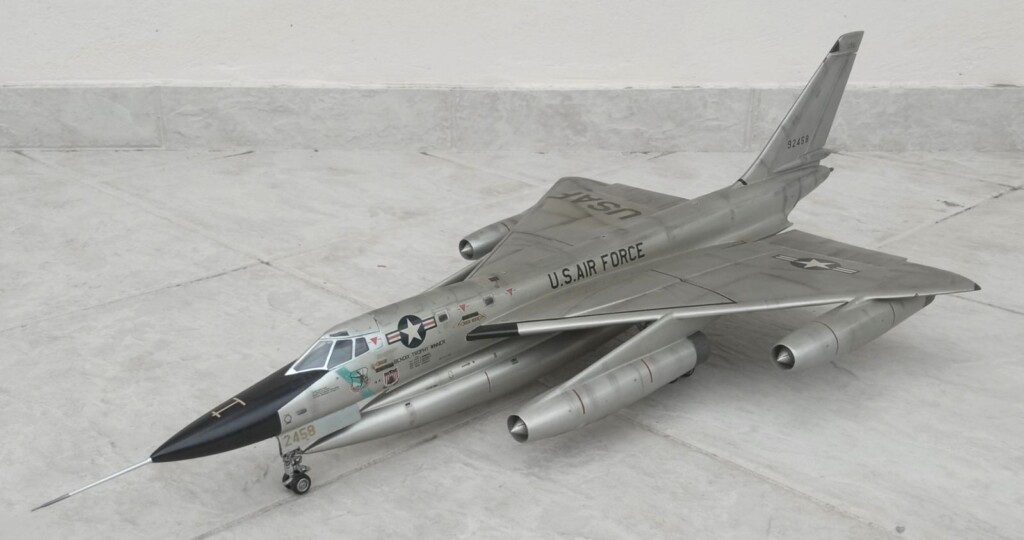

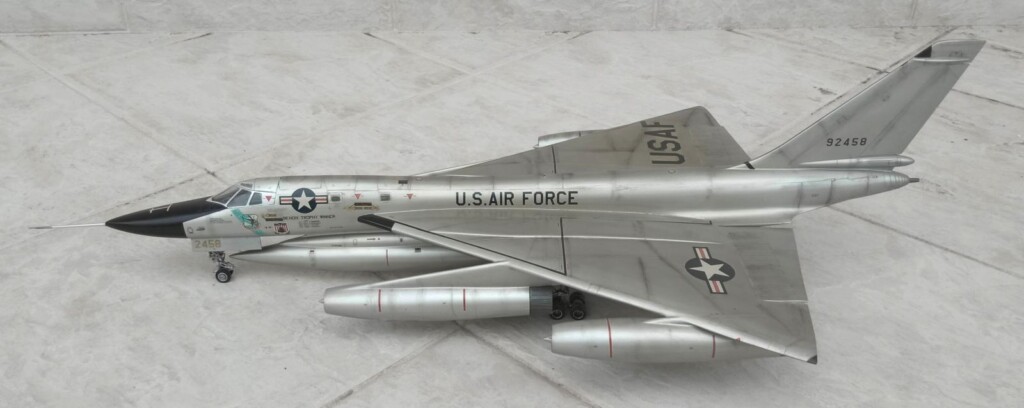
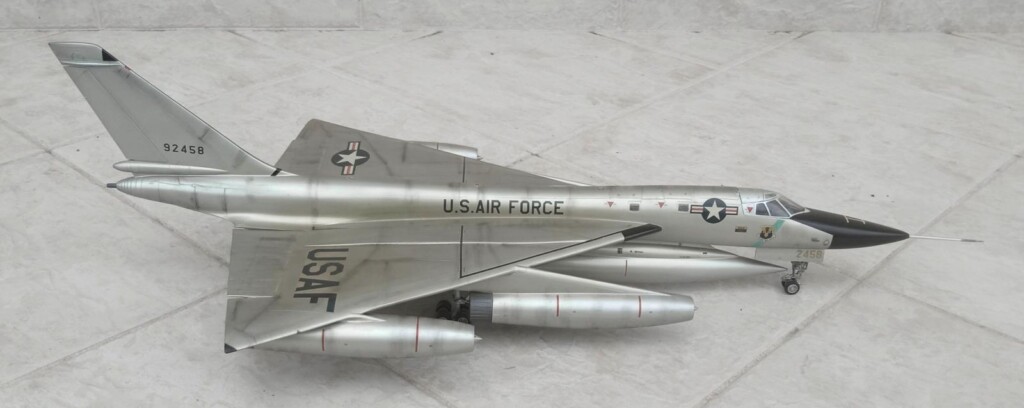
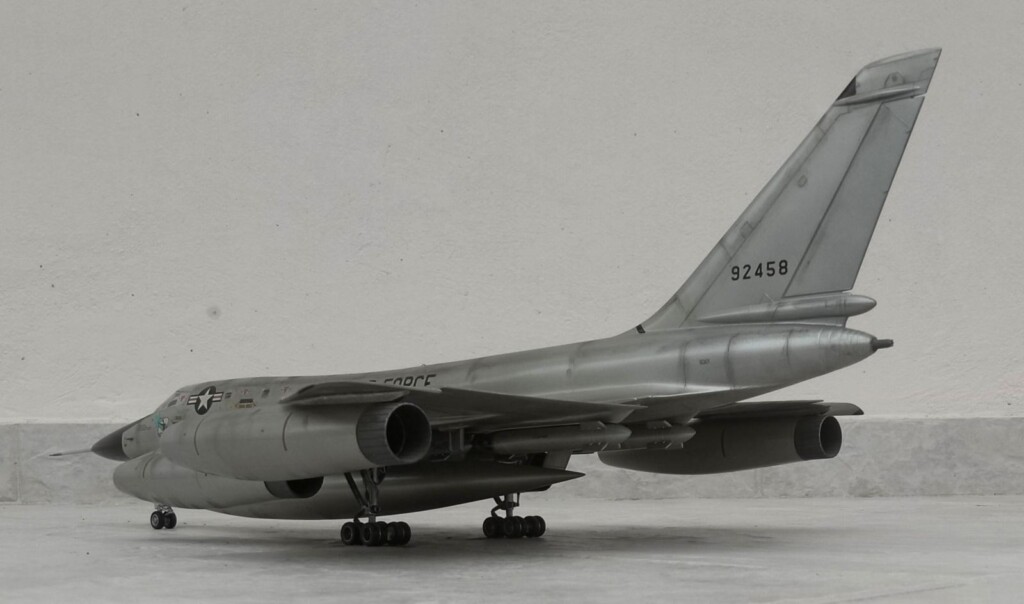
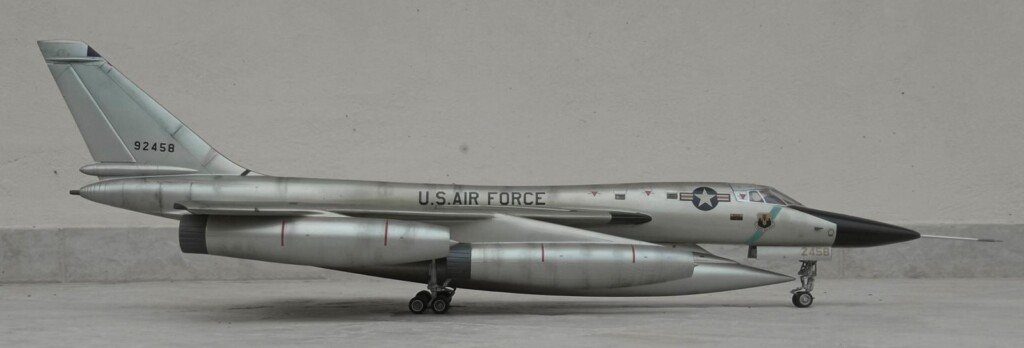
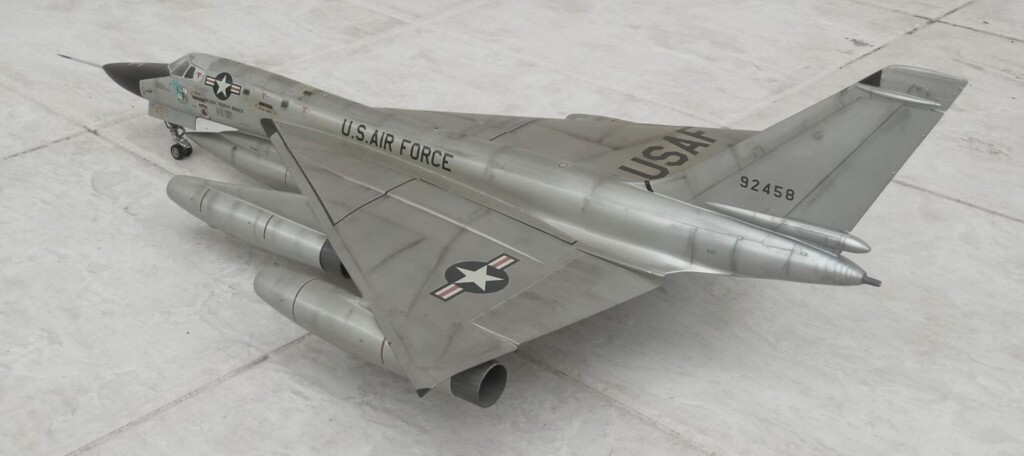
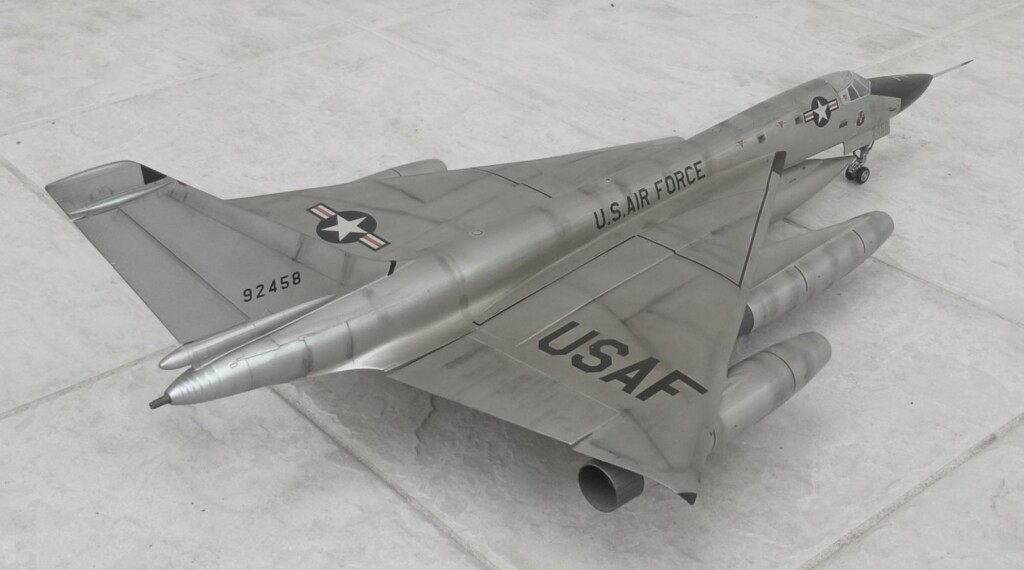
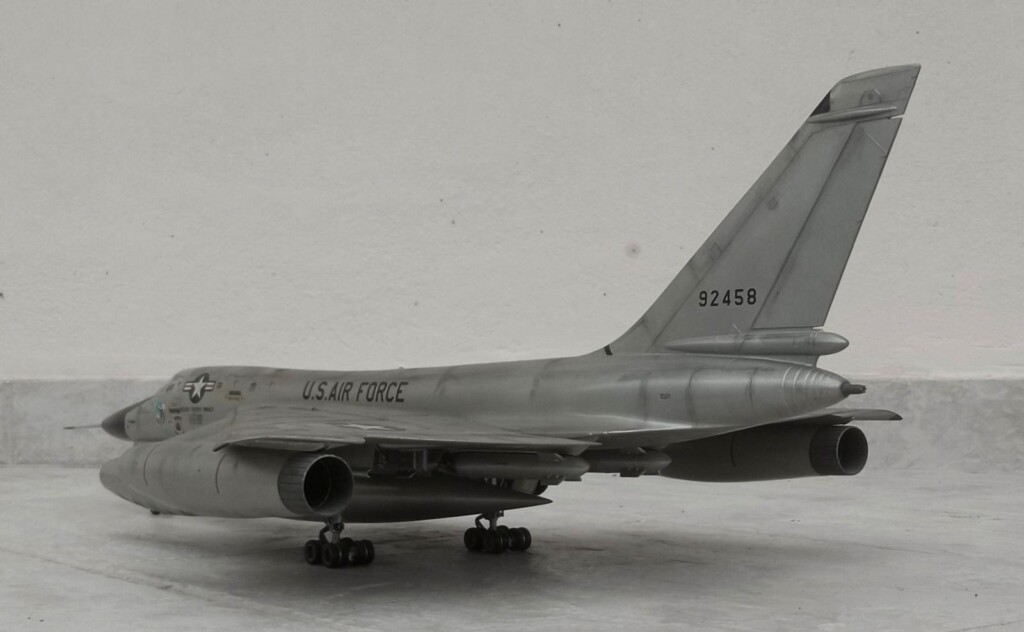
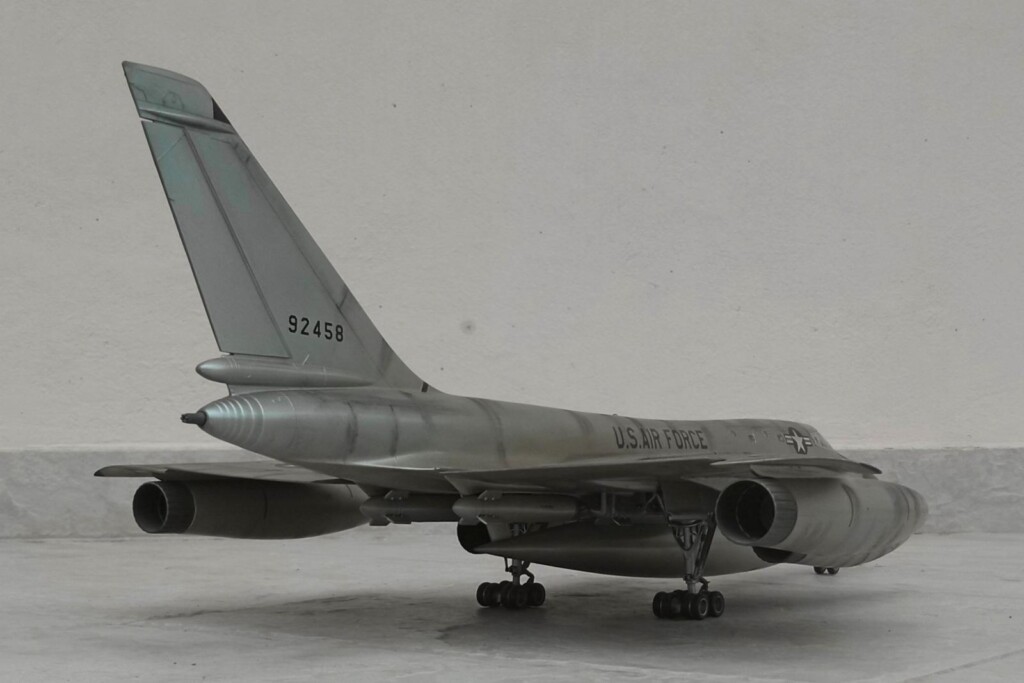
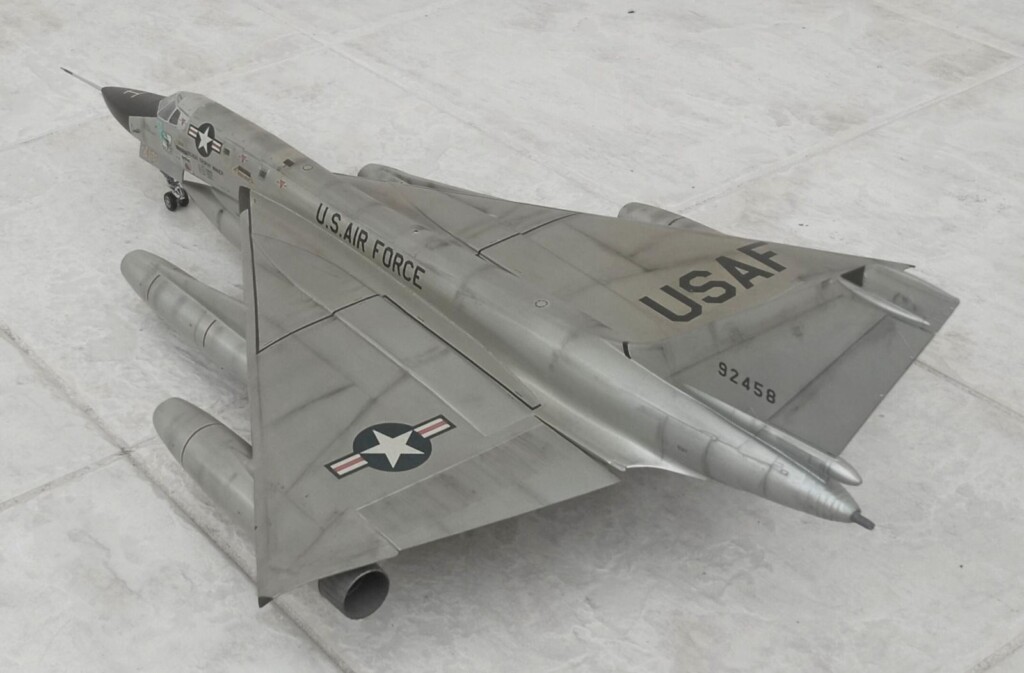
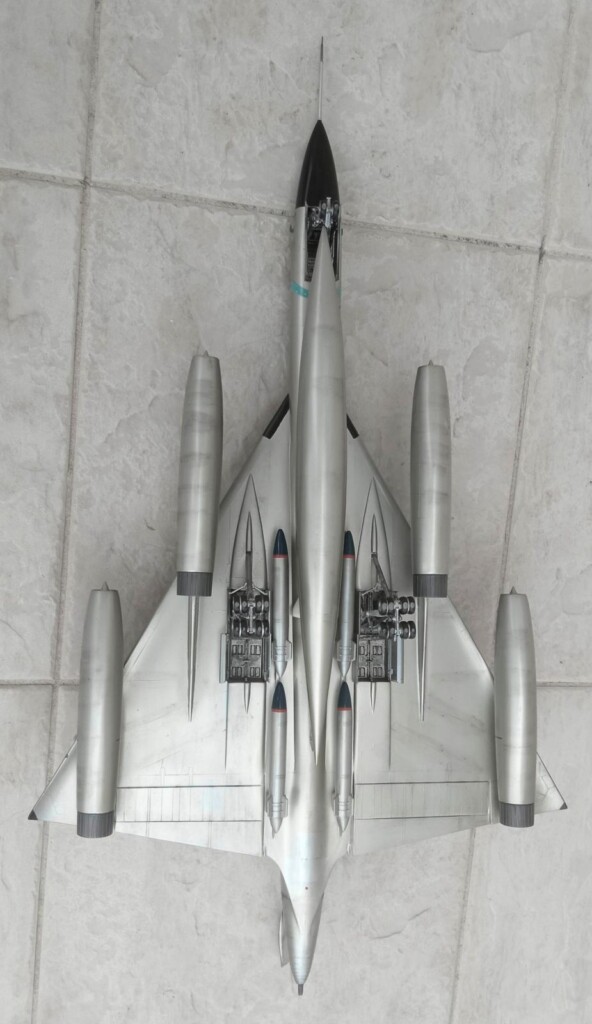
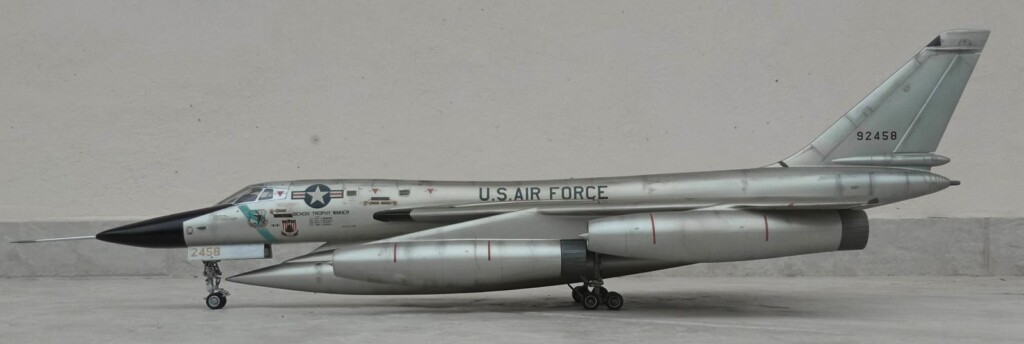
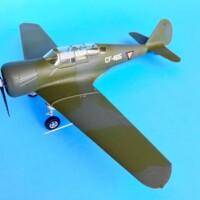
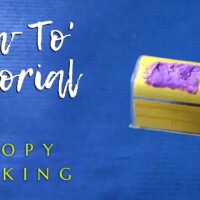
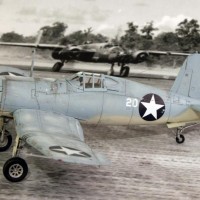
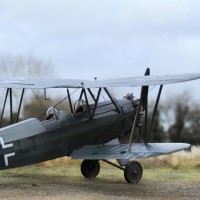
Excellent work on what is a beast of a kit (plus bonus points for NMF.) I wish I had finished mine, but it's too much for me.
Thanks so much, my friend @dbdlee!
Nice build of a vintage kit, looks good Spiros
Thanks a lot, my friend @gelleb18!
Looks really nice! @fiveten
Thank you kindly, my friend @jdtruby!
I know a lot of work went into this beast, Spiros. Well done!
Thanks so much, my friend @j-healy!
Well done Spiros. I was unaware of this kit
Thank you very much, my friend @blackadder57!
Wow, what a stunning Cold War bomber. The thing must be huge in this scale!
Excellent piece of work and an interesting write up.
Thanks a lot, my friend @alfred!
What a wonderful build, Spiros @fiveten
You presented it with a great article, thanks for sharing.
The NMF looks fantastic. This one will definitely occupy a lot of space on the shelf.
Thank you very much, my friend @johnb! Yes, big!
Beautiful job Sir! Almost makes me want to open mine up!
Thank you kindly, my friend @butchbryan! Looking forward to yours!
How did you sneak in this beast, Spiros (@fiveten), with all the other models you are building? Looks awesome. Now I want to go find mine and take a swing at it. Well done.
Thanks a lot, my friend @gblair! It was an older build that lately received its final touches.
Absolutely lovely build. By chance i pulled my '85 boxing off the shelf last week, and started doing some test fitting of some of the main parts. Tempted even more now, upon seeing your great build, to give mine a proper start. The NMF looks great, as does this old kit straight out of the box.
Thanks a lot, my friend @pb_legend! Looking forward to yours!
The B-58 goes fast just parked. Wow.
Thanks a lot, my friend @kahu! Indeed!
The Hustler is a beautiful aircraft but I’ve held off buying the Monogram kit because of its nasty build reputation. You’ve proven that it can be built into an awesome representation of a classic aircraft. Fantastic build my friend @fiveten!
Thank you so much, my friend @tolss!
The B-58 is one of those aircraft that looks really special. You've done an excellent job on what is a big kit and the end result fully justifies all the effort. Really great work.
Thank you kindly, my friend @christopher!
Terrific Hustler! Very informative and well researched text too, Spiros @fiveten. I stood in awe under one of these sleek beasts last year at Pima Air & Space in Tucson so I can easily visualize how much shelf space this bird must occupy.
Thanks a lot, my friend @eb801! Yes, it does occupy a lot of shelf space!
Amazing build Spiros!
Thanks so much, my friend @blackmopane!
A wonderful nmf build of a true cold war classic, love it! I‘m sure it must be big. I remember that my dad build one as a kid in the 60ies, Spiros @fiveten.
Thank you so much, my friend @fxrob!
I remember having that kit at one time and deciding I didn’t have room to display it (and being intimidated by the amount of work it was going to take to complete it). I am very impressed with your model! Your great work has turned out an excellent model!
Thank you so much, my friend @guitarhack5!
What memories. As a kid in the 1950s I had a toy metal B 58. Loved it. As big as it is, at the Pima Air & Space Museum it is dwarfed by the B 36 and B 52. Great to see them almost side by side. Super job on this model
Thank you very much, my friend @markhedrick!
Spiros, I hope you have a lot of space in your shelves. This is massive (and also very beautiful).
Thank you so much, my friend @marcellorosa1!
We don’t see too many of these built, Spiros, maybe the size puts people off, but this is a magnificent example, thanks for sharing with us.
Thank you kindly, my friend @chinesegeorge!
Nice! You don't see many 1/48 Hustlers built, and yours fires on all 4 cylinders - or should I say turbines?
As big as it is, I always thought that the Hustler was a lot smaller than I thought it would be. With those 4 huge J79s no wonder why it needed that huge belly tank.
Excellent job, Spiros (@fiveten). Excellent job on the build and the Nm finish and on yet another MM posting.
Thanks so much, my friend @georgeswork!
Another stellar build and history lesson, Spiros! 😃 She does look magnificent with that NMF so well applied. 🤩
I love seeing this iconic Cold Warrior built @fiveten! 👏
Thanks as always for your wonderful comment, my friend @garybrantley!
Spiros, @fiveten, you continue to amaze me at the quantity and variety of builds. This one is very nice, of a great plane and challenging kit. I had one in my stash for many years, with no real plans to build it. I always love seeing one built though and think you did a great job on this one.
Thanks for your kind comments, my friend @luftwaffe-birdman!
Niiice! A real beauty Spiros. Of late some say it amounted to politics, why the B-58 was put out of service, apparently. it adapted well to low level flight in response to the growing SAM threat. Also, the accident rates fell off when it reached operational status.
Thanks so much, my friend @roofrat! Pity this beauty flew for such short time.
Great build Spiros! Would fit right into our next-year show theme: Nato vs. Eastern Bloc: Icons of the Cold War.
Thanks so much, my friend @gkittinger!
It definitely would!
Beautiful build, Spiros! An inspiration for the still-sealed original issue copy I bought at our recent show here in New Braunfels for a "decent" price.
Back in the mid-'60s my family lived in Richardson, TX, ( a suburb at the north side of Dallas) and occasionally we'd here a sonic boom, which I was told were caused by B-58s transiting the area during the trip from the Convair plant in west Ft. Worth to Bunker Hill / Grissom AFB, Indiana, where the 2nd unit of B-58s were based (the 305th BW).
Then in 1980 or '81 I was on the crew that off-loaded a B-58 from a C-5 at the General Dynamics plant in Ft. Worth (formerly Convair) for an upstart museum at the front gate of the plant. For it to fit into the C-5, the outer wing panels were cut just outboard of the outer engine pylons, and the vertical stab had been removed. But it was on its gear and we towed it down the line to the museum area. The museum never really got off the ground (so-to-speak), and, last account I had, that aircraft is now at the base museum at Little Rock AFB, Arkansas.
Thanks so much, my friend @baker2-bits!
You were lucky to be in that crew who offloaded that example!
As another aside, the B-36 that is now in the Pima Air Museum in Tucson is another victim of the "Fort Worth Aviation Museum" that never was. It was the last B-36 to come off the production line and was named "The City of Fort Worth". In 1979, as an F-111D Standardization/Evalutation Pilot, I went to the Fort worth General Dynamics plant for an F-111 Flight Manual review board. At that time the B-36 was at the front gate to the plant. Each day, retired engineers and maintenance workers came and worked to restore it. When the concept of the museum "went West", so did the B-36...to Tucson.
Interesting facts, my friend @trod348.
WOW Spiros!
beautiful work and well NMF...
As soon as I have time I'll read your whole article... the "Delta" bomber is fantastic and your interpretation too 🙂
Thank you so much, my friend @dapo68!
Superb work Spiros. What a great looking finish and kit. Love it.
Thank you very much, my friend @graemestreet!
Spiros,
You NAILED IT! This is a magnificent Hustler. The finish is sooo perfect. On a personal note, both my grandparents worked for Convair in the Hustler era and help build these Cold War birds.
Thanks for sharing.
Thank you very much, my friend @coondog! I am sure your grandparents had many great stories to tell for the Hustler!
Spiros, this is just a masterpiece! I'm a huge fan of this cold war warrior and your build make her justice. Well done!
Thank you so much, my friend @george72!
Interesting information and once again a superbly built model. The aluminum paneling looks really good.
Thanks so much, my friend @milantesar!
Great job Spiros! That NMF is fantastic.
The B-58 is a really neat plane to see in person. These are some pics of the one in the SAC's musuem in Ashland, Nebraska.
3 attached images. Click to enlarge.
Thank you so much, my friend @eydugstr!
Wonderful pics!
Great job Spiros! The overall metal finish and weathering came out spot on, she's a beauty!
Thank you very much, my friend @v1pro!
Beautiful build. That kit is an absolute beast. Great history and very well done!
Thanks so much, my friend @jimh!
Very nice finish brother, especially so when one considers the origin of the model. Big time extra points for grinding this one out
Thank you very much, my friend @markh!
Wonderful! It's hard to tell the difference between the real thing and the scale model!
Thank you kindly, my friend @gaubert!
Great looking model Spiros. In 2000 I wandered around Pima and here's what their B-58 looked like at the time.
1 attached image. Click to enlarge.
Thank you so much, my friend @jdr986! Pima's B-58 wouldn't mind some extra attention.